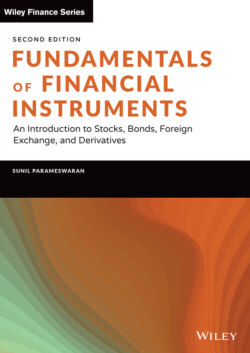Читать книгу Fundamentals of Financial Instruments - Sunil K. Parameswaran - Страница 36
EXAMPLE 1.2
ОглавлениеPeter Norton has acquired an options contract that gives him the right to buy 100 shares of ABC at a price of 42.50 per share after three months from Mike Selvey. If the price of ABC shares after three months were to be greater than $42.50 per share, it would obviously make sense for Peter to exercise his right and acquire the shares. Otherwise, if the share price were to be lower than $42.50, he can simply forget the option, and buy the shares in the spot market at a lower price. Notice that he is under no compulsion to exercise the option, for it confers a right on the holder, and does not impose an obligation. If Peter were to decide to exercise his right to buy, however, Mike would have no choice but to deliver the shares at a price of $42.50 per share. Thus, options contracts always impose a performance obligation on the seller of the option, if the option holder were to exercise that right. The reason is that when two parties enter into an agreement for a transaction that is scheduled for a future date, then at the time of expiration of the contract, a price move which translates into a profit for one of the two parties will obviously lead to a loss for the other. Hence, we cannot have a contract that confers both the parties with the right to perform, for the party who is confronted with a loss will simply refuse to perform. Thus, either we can have contracts that impose an obligation on both parties, such as forward and futures contracts, or we can have a contract that confers a right on one party and imposes an obligation on the other, which is essentially what an options contract does.
When a person is given a right to transact in the underlying asset, the right can obviously take on one of two forms. That is, that person may either have the right to buy the underlying asset, or the right to sell the underlying asset. Options contracts that give the holder the right to acquire the underlying asset are known as Call options. If the buyer of such an option were to exercise that right, the seller of the option is obliged to deliver the underlying asset as per the terms of the contract. Peter, in the previous example, obviously possesses a call option.
There exist options contracts that give the holder the right to sell the underlying asset. These are known as Put options. In the case of such contracts, if the holder were to decide to exercise his option, the seller of the put is obliged to take delivery of the underlying asset.
Options give the holder the right to buy or sell the underlying asset. If the contract were to permit exercise only at the time of expiration, the option, whether a call or a put, is known as a European option. If such an option were not to be exercised at the time of expiration, then the contract itself would expire. There exists another type of contract, where the holder has the right to transact at any point between the time of acquisition of the right and the expiration date of the contract. These are referred to as American options. Quite obviously, the expiration date is the only point in time at which a European option can be exercised, and the last point in time at which an American option can be exercised.
An options contract, whether a call or a put, requires the buyer to pay a price to the seller at the outset, for giving the right to transact. This price is known as the option price or option premium. This price is nonrefundable if the contract were not to be exercised subsequently. If and when an options contract is exercised, the buyer will have to pay a price per unit of the underlying asset if exercising a call option, and will have to receive a price per unit of the underlying asset if exercising a put option. This price is known as the exercise price or the strike price. The difference between the two prices is that while the option premium has to be paid at the very outset, the exercise price enters the picture only if the option is exercised subsequently. Thus, the exercise price may or may not be paid/received eventually. Futures contracts are termed as commitment contracts, for they represent a binding commitment for both parties. Options, on the other hand, are termed as contingent contracts for they will be exercised by the holder only in the event of it being profitable. In the case of calls, this will be contingent on the asset price being greater than the exercise price, whereas in the case of puts, it will be contingent on the asset price being lower than the exercise price.
Futures and forward contracts, however, do not require either party to make a payment at the outset, because they impose an equivalent obligation on both the buyer and the seller. The futures price, which is the price at which the buyer will acquire the asset on a future date, will be set in such a way that the value of the futures contract at inception is zero, from the standpoint of both the buyer as well as the seller.
